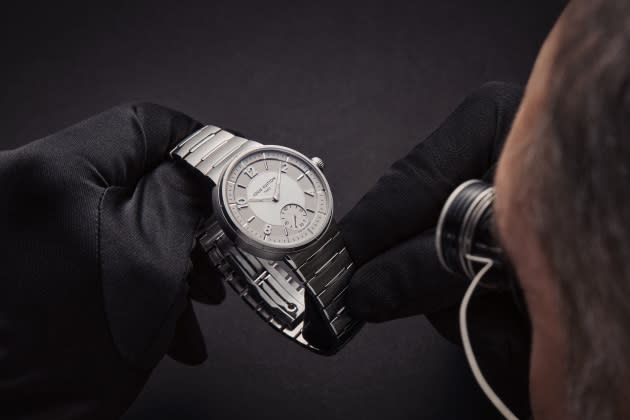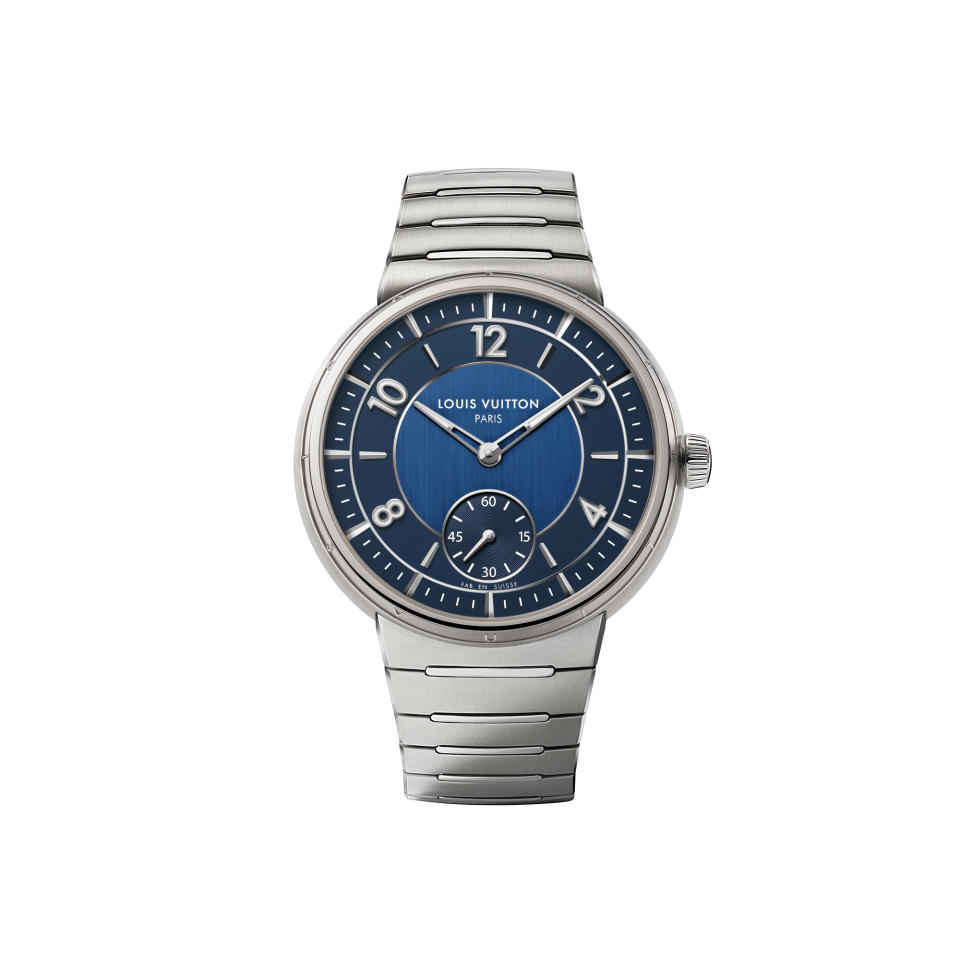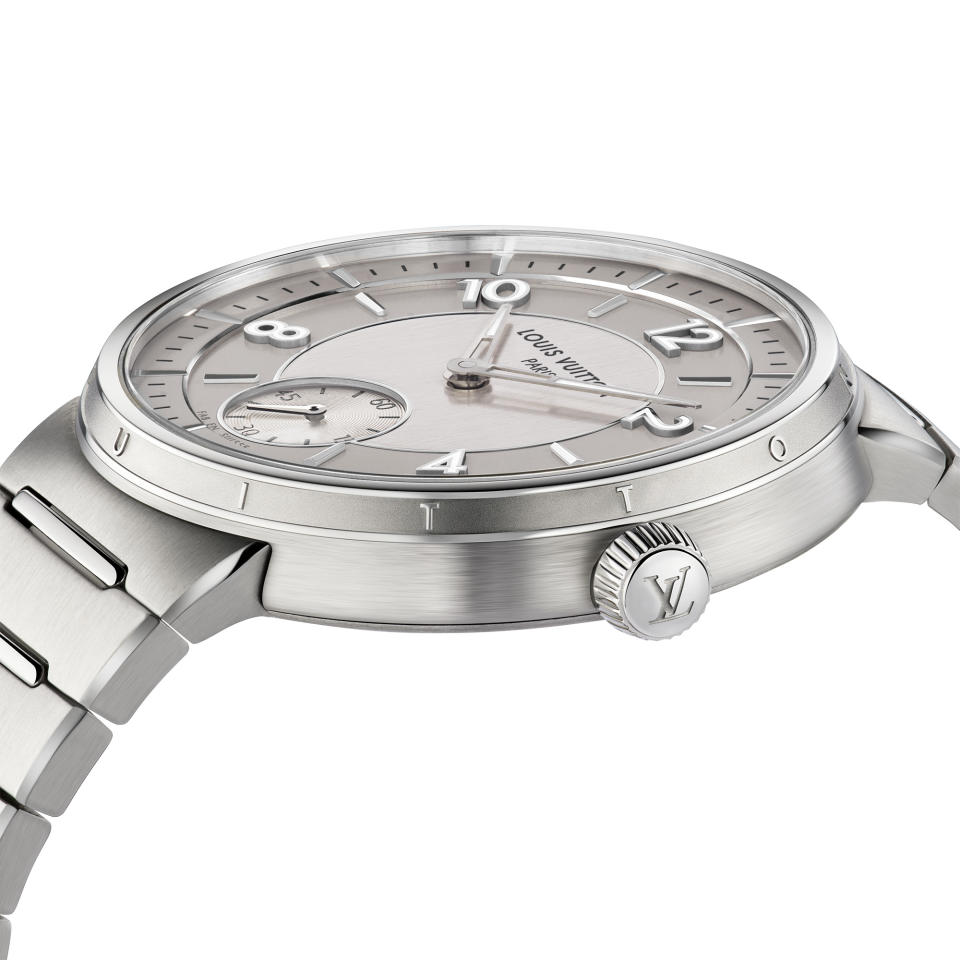Louis Vuitton Unveils New Tambour Watch, Cuts 80 Percent of Lineup as Part of Upscaling Strategy

PARIS — Stop the clocks for Louis Vuitton’s watches.
As of Wednesday, 80 percent of the luxury French house’s timepieces will be retired, as part of an upscaling move that will be completed in September with the launch of a new Tambour design.
More from WWD
Pharrell Hits a Billion, Moschino Taps Yu, Dior's Bright Touch
Pharrell Williams' Debut Show for Louis Vuitton Garnered More Than 1 Billion Views
The new style will be a three-hand streamlined take on the French house’s flagship model, with an integrated bracelet. But the biggest novelty will be the price point, which will leap by a fivefold factor.
“It’s not a revolution for the market, but it’s a revolution for us because of everything we are retiring and a new price point. On the scale of the brand it’s a small gamble, but for Louis Vuitton watches, it’s truly a radical change,” Louis Vuitton director of watches Jean Arnault told WWD.
“Going from a 4,000 euro price average to the 20,000-and-up range in one go is a daring gamble. It’s true that we have a lot of unknowns in doing this,” he said.
“We don’t have a sales target, or a goal of growing by such-and-such percent annually. We are going to build growth little by little to be sure to have an irreproachable quality for the client and legitimacy.”

The brand’s lineup will go from more than 100 active references to around 20, including a handful of women’s watches, the connected Tambour Horizon Light Up watch, the Tambour Street Diver launched in 2021, and the five new Tambour models, with high watchmaking on top of that. All of these will be covered by a five-year warranty, up from three.
According to the executive, today’s Louis Vuitton watch clientele is split between those who buy watches as fashion accessories and watch enthusiasts and collectors.
But the perspective of losing the first category doesn’t faze him, even though he imagines them reaching for the connected watch and its customizable digital watch faces to match their outfits.
“Whatever the performance we have today — and it’s rather good — I’m not looking at it to pilot this change,” Arnault said, deeming the Tambour iteration the brand’s biggest watch launch of the past 20 years.
“Our goal is not to put a watch on everyone’s wrist. It’s to ensure that our historical collectors, our brand aficionados can recognize themselves in a more entry-level high-end watchmaking piece,” he continued. “There’s also this idea of respecting long-standing clients and bringing value to what they’ve already collected.”
In a nutshell, the positioning is about showing how serious the French luxury house is about its watchmaking chops.
He is “not interested in tripling the business by maximizing, lowering prices and doing more volume.” Instead, this step is about “leveraging the know-how of our craftspeople and ensure that a client entering a Louis Vuitton store — for the watches or by chance — will see that [these pieces] have a level of execution on par” with watchmaking pure players.
Arnault said the move was part of a long-game strategy that stretches to 2030, “whatever the result of this collection.”
“We aren’t going to change strategy midway because it didn’t work,” he continued. “We’re not going for an exceptional success or launching with a bang. It would be arrogant to think that way. But we are installing ourselves step by step, building a stable business.”
This is the “good fortune of being part of a big house that’s historically believed in watchmaking,” initiated with the 2002 launch of the first Tambour design and furthered by investing in La Fabrique du Temps to “create high watchmaking in a more spontaneous way, without having to think about an immediate return on investment,” he said.
In preparation for the cutover, production of the outgoing watch models was halted 18 months ago and the new models won’t roll into stores until September, which Arnault described as a pause that would allow the brand to explain the new direction to would-be buyers.
Considered a unisex model, the new 40-mm Tambour watch will come in two steel options with either a silver-gray or a deep blue dial, both priced at 19,500 euros; a steel-and-gold model; one in solid 18-karat yellow gold, and a rose gold version.
Among the immediately visible design changes are the absence of lugs and the integrated bracelet but also a slimline profile of just over 8 millimeters — against 13 for the current Tambour designs — that has been designed to appear even thinner.

Inside is the LFT023 proprietary movement designed by Louis Vuitton and codeveloped by Swiss movements specialists Le Cercle des Horlogers, a choice Arnault said was akin to calling on a racing engine manufacturer when launching a new car.
“It would have taken us four or five years before arriving to a satisfactory level of robustness, by the time they had something tested and ready,” he explained. “I didn’t want to launch an unreliable product on the market just for the sake of saying we do everything [in-house].”
Don’t expect new dials or a flurry of complications coming down the line at a rapid pace, either. In fact, he’s setting other priorities for the 20 to 30 watchmakers of La Fabrique du Temps, such as fully bespoke pieces, working on a particular model from start to finish, or developing high complication pieces.
“Today, we are organized to make small series, unique pieces. It’s not natural to us to do large runs of 1,000, 2,000, 4,000 pieces,” he said, before adding that less than production capacity itself, it would mean concessions around design or finishings.
Beyond the brand’s business, he also felt the strategic move fits with sweeping changes in society, where “there is a growing appreciation of craft and less consumption, where instead of having 10 watches, you’ll only have one — but it’s magnificent.”
Best of WWD


